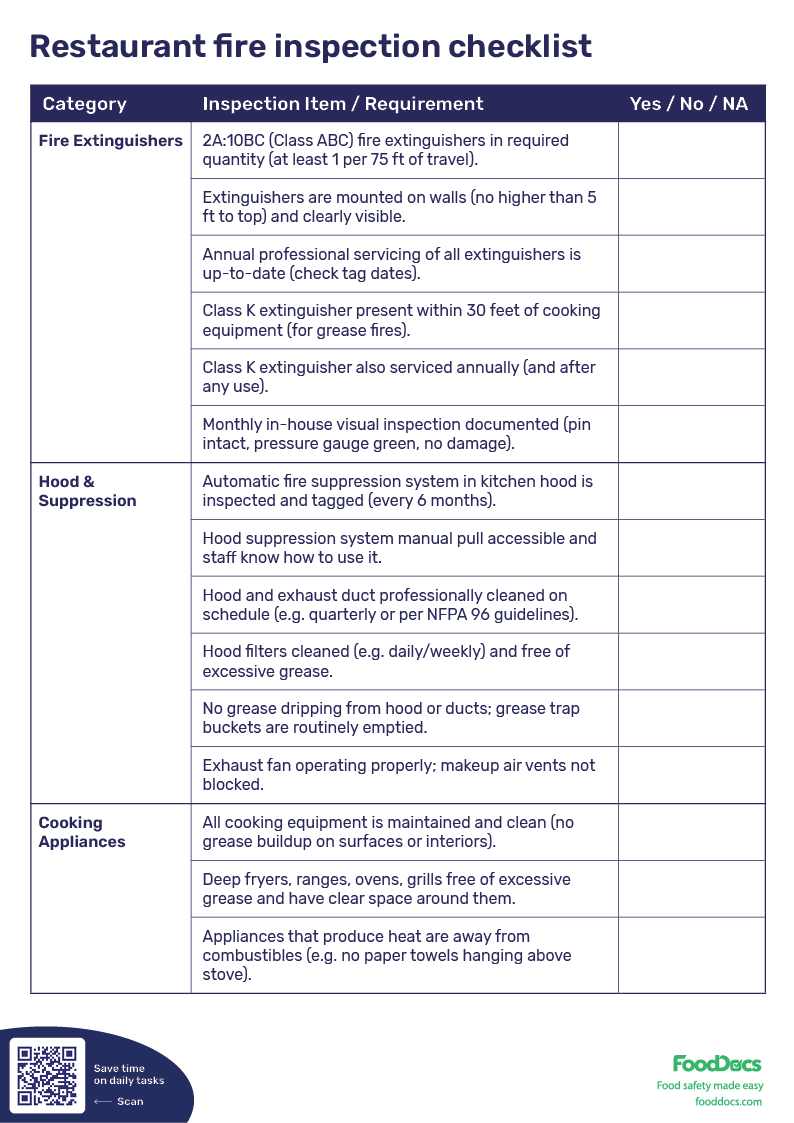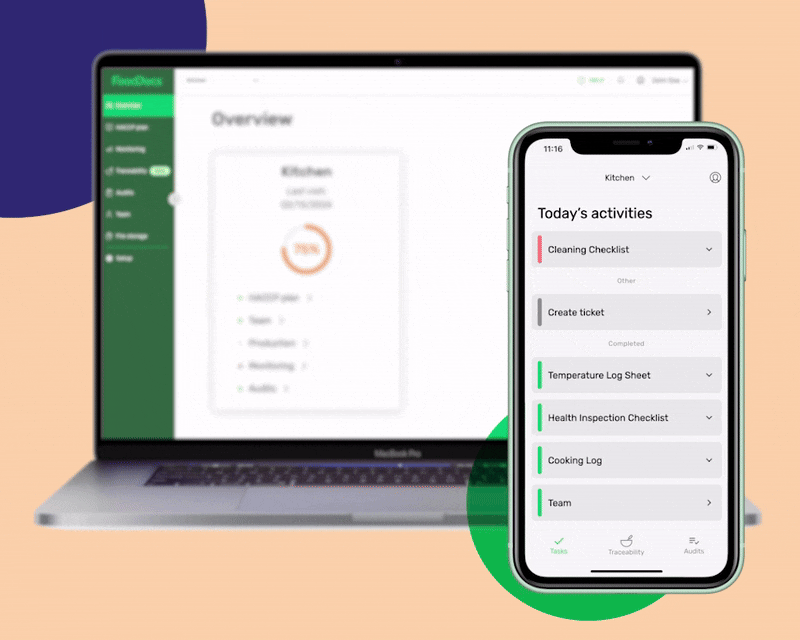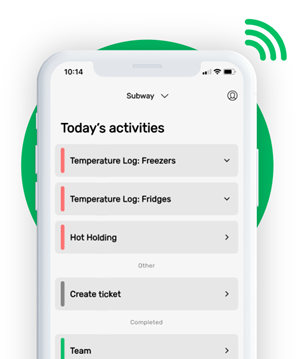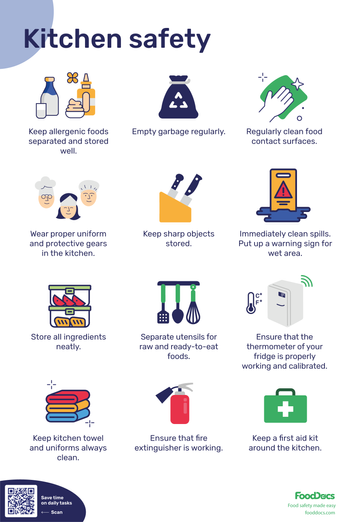RESTAURANT FIRE INSPECTION CHECKLIST | FREE DOWNLOAD




This is how our Digital Food Safety platform saves 20% of your time on daily tasks:
- Get upcoming task notifications
- Add data into the app
- Check the status of tasks in real-time

When food safety was still handled on paper, I typically spent a couple of hours per day getting the papers and going around checking or completing tasks… Now I can sit down and it's just all there in one place. It takes me 5-10 minutes.
Ruth B.
Store Manager
Maintaining fire safety in a restaurant is about more than avoiding fines. It’s about protecting your employees, customers, and business. According to the National Fire Protection Association (NFPA), cooking equipment is the leading cause of restaurant fires, accounting for over 60% of fires in eating and drinking establishments and resulting in more than $165 million in property damage each year.
A restaurant fire inspection checklist helps you stay on top of fire safety, ensuring your restaurant meets fire codes and is prepared for the next inspection. In this guide, we provide an industry-approved checklist (printable table included), reference U.S. fire safety codes (like NFPA standards), and share real-world examples of common fire safety mistakes. Use this information to create a safer restaurant and pass your fire inspection with confidence.
Key takeaways
-
Restaurant kitchens are high-risk areas, and over 60% of restaurant fires start from cooking equipment, making proper suppression and ventilation systems essential.
-
Regular fire system maintenance—including hood cleaning, extinguisher checks, and alarm testing—is critical to passing inspections and ensuring safety.
-
Grease buildup in hoods and on appliances is a leading cause of fires, and must be cleaned on a set schedule based on kitchen volume.
-
Restaurants must have the correct type and number of fire extinguishers, including Class K near cooking equipment, and keep them serviced and accessible.
-
Exit routes must remain unobstructed and doors easily openable at all times to meet fire code and protect patrons in emergencies.
-
Improper use of extension cords and power strips is one of the most cited violations, and they should never be used as permanent wiring solutions.
-
Staff training in fire safety procedures and extinguisher use significantly reduces risk and improves inspection outcomes.
-
Common fire code violations include blocked exits, expired extinguishers, poor storage practices, and unclean grease traps, all of which can be proactively corrected.
-
Restaurants should conduct monthly self-inspections using a fire safety checklist to catch and fix issues before the fire marshal does.
-
Using FoodDocs' food safety management software to digitize and keep organized records of inspections and maintenance signals diligence to inspectors and helps resolve any issues quickly.
Why do fire inspections matter for restaurants?
Fire inspections are typically conducted by your local fire marshal or fire department at least annually (sometimes unannounced). These routine inspections ensure that your restaurant complies with fire safety codes intended to prevent fires or minimize harm if one occurs.
Failing a fire inspection can lead to fines, closure until violations are corrected, higher insurance premiums or, worst of all, increased risk of a catastrophic fire. Given that restaurants deal with open flames, hot equipment, cooking oils, and crowds of customers, fire safety must be a top priority.
U.S. Fire Code References: Restaurants in the U.S. must follow local fire codes, which often incorporate standards from the NFPA and the International Fire Code (IFC). Key NFPA standards for restaurants include:
- NFPA 96 (Ventilation Control and Fire Protection of Commercial Cooking Operations)
- NFPA 10 (Portable Fire Extinguishers)
- NFPA 13 (Sprinkler Systems)
- NFPA 101 (Life Safety Code for exits and egress)
- NFPA 70 (National Electrical Code), among others
For example, NFPA 96 mandates regular cleaning and maintenance of kitchen exhaust systems to prevent grease fires, and NFPA 10 requires specific types of fire extinguishers (like Class K for grease fires) with annual servicing. By understanding what inspectors look for — and why — you can better prepare your facility.
What are the 6 key fire safety areas in a restaurant?
Every restaurant fire safety plan should include guidance for these locations. Fire inspectors will examine several broad areas of your restaurant’s fire safety. Below are the main categories and what you need to know about each:
1. Kitchen suppression and ventilation systems
Cooking areas are high-risk, so the fire suppression and ventilation systems there are critical. Inspectors will focus on the hood system above your cooking equipment:
- Automatic fire suppression system: Restaurants with fryers, griddles, or open-flame cooking must have an automatic hood suppression system (e.g., ANSUL system) installed per code. Ensure it has been inspected and serviced semi-annually by a licensed contractor. Updated inspection tags should be on the system, and keep the inspection report on-site. This system is designed to automatically release a fire-suppressant chemical if a stove or fryer fire occurs.
- Grease buildup and hood cleaning: Grease residue ignites easily. Improperly cleaned hoods account for 1 in 5 of all restaurant kitchen fires. Clean the hood filters frequently (e.g., daily or weekly) and have the entire exhaust duct and hood professionally cleaned on the schedule recommended by NFPA 96. NFPA 96 guidelines suggest cleaning monthly for solid-fuel cooking (e.g., wood or charcoal grills), quarterly for high-volume kitchens (24/7 operations or charbroiling), semi-annually for moderate-volume, and at least annually for low-volume operations. Keep records of all cleanings for the inspector.
- Ventilation system maintenance: The exhaust fan and ductwork should be in good working order. Inspectors will check that filters are in place and grease isn’t dripping. Make sure no one has propped open or bypassed the filters – all grease vapors must be properly captured. Also ensure the duct has access panels for cleaning (a requirement of NFPA 96) and that there are no holes or improper repairs.
- Fire suppression links and nozzles: The hood suppression system has fusible links or sensors that trigger it; these must be replaced periodically (usually annually) and kept free of heavy grease. The spray nozzles above cooking equipment should not be obstructed or coated in grease. Never repaint or cover these nozzles, and make sure protective caps (if any) are removed by the service tech after inspection.
Keeping your kitchen's suppression and ventilation system clean and professionally serviced will help mitigate the biggest fire risks and satisfy a major portion of the inspection requirements.
2. Portable fire extinguishers
Every restaurant needs the right type and number of portable fire extinguishers, placed in the correct locations, with current inspection tags:
- Type and placement: At minimum, you’ll need Class ABC extinguishers (often 2A:10BC rated, 5-pound units) for general fires and Class K extinguishers for kitchen grease fires. A common requirement is to have at least one 2A:10BC extinguisher for every 75 feet of travel distance. Class K extinguishers (for cooking oil fires) must be within 30 feet of commercial cooking equipment. Mount extinguishers prominently on walls (near exits or hazard areas) no higher than 5 feet off the floor so they’re easily accessible. Signage or labels should mark their locations clearly.
- Maintenance and inspection: Fire extinguishers should have an inspection tag showing the last professional service date. NFPA 10 requires a certified technician to service (inspect, test, and recharge) each extinguisher annually. In between these professional checks, you (or your staff) are expected to perform monthly visual inspections – verify the gauge is in the green, the pin and tamper seal are intact, the extinguisher isn’t damaged or obstructed, and the instructions are legible. Keep a log of these monthly checks. An inspector will look at the tags and may ask if you’re doing your monthly inspections.
- Proper use and training: Make sure your staff know how to use a fire extinguisher (remember “PASS” – Pull, Aim, Squeeze, Sweep) and which extinguisher to use for which type of fire. Using an incorrect extinguisher (for example, a water-based one on a grease fire) can worsen the fire. Many fire departments or safety companies offer brief training for employees – this is highly recommended, and in some jurisdictions, required for at least one staff member on duty.
- Condition: Inspectors will check that extinguishers are fully charged (needle in the green zone) and not expired. If an extinguisher was used (even partially), recharge or replace it promptly. Also ensure not blocked – nothing should impede quick access in an emergency.
Having ample, well-maintained fire extinguishers is not just about passing inspection; those extinguishers are your first line of defense if a small fire breaks out. A quick response with the right extinguisher can prevent a minor flame from turning into a restaurant-engulfing blaze.

3. Exits, egress, and emergency lighting
Emergency exits and escape routes are a critical aspect of fire safety. During a fire inspection for a restaurant, the officer will ensure that people can evacuate quickly and safely:
- Unobstructed exit paths: All exit doors, aisles, and pathways must remain clear of obstructions at all times – not even during deliveries or rush hour. It’s a common violation to find boxes, chairs, or clutter blocking an exit route. Even temporarily placing items in front of exits “just for a few minutes” is dangerous and can lead to fines. Make it a policy that nothing is ever stored in front of emergency exits or in exit corridors.
- Exit doors requirements: Exit doors should open easily from the inside without any special knowledge or tool. That means no keys, no padlocks, no deadbolts that require a code when exiting. The classic rule (from NFPA 101 Life Safety Code) is that one motion (turning a handle or pushing a panic bar) must unlatch the door for egress. If you have a secondary exit door you don’t use for customers, do not seal it or install an improper lock. If it’s required as an emergency exit, it must function. During business hours, exit doors should never be chained or bolted shut. (If security is a concern, use panic hardware that locks from the outside but always allows free egress from the inside.)
- Exit signage: Lighted “EXIT” signs are required to mark exits and pathways to them. Inspectors will check that exit signs are illuminated and not burned out, and that they have a battery backup or generator power for emergencies. If your exit signs flicker or part of the sign is unlit (“EX” not glowing, for example), replace the bulbs or the unit. Nothing should obscure an exit sign – no decorations, banners, or shelving in front of it. Test exit signs and emergency lights monthly (there’s usually a test button) and document it. Fire codes typically require monthly activation tests and an annual 90-minute full-duration test of emergency lighting.
- Emergency lighting: In addition to exit signs, any windowless areas or exit routes likely need emergency lighting – these are usually the battery-backed flood lights that kick on if power fails. The fire inspector will often kill the power (or ask you to hit the test switch) to see if emergency lights and exit signs stay lit. Ensure these units work and cover all needed areas. Replace batteries per the manufacturer’s schedule (many do so annually, often at the same time as exit sign batteries).
- Exit doors and hardware condition: Doors must be in good shape – they should close and latch by themselves (especially fire-rated doors like kitchen to dining room if required). If you have a fire door (self-closing door assembly meant to contain fire), never prop it open with wedges or tape; use magnetic holders tied to the alarm if it must stay open. NFPA 80 standards require that fire doors remain closed unless an automatic release device is used. The inspector will check that any fire doors close properly. Additionally, exit door hardware (panic bars, handles) should be functional and not overly difficult to operate.
- Capacity and exit count: Ensure you have the proper number of exits for your occupancy load. Most restaurants require at least two exits remote from each other. If your occupant load (posted on your occupancy certificate) is above certain thresholds, make sure your exit doors and pathways meet width and capacity requirements per code. Also, post the maximum occupancy sign if provided by the fire department, and do not exceed it. Overcrowding can be cited as a violation as it impedes quick evacuation.
Think of egress as your customers’ lifeline during a fire. By keeping exits obvious, unlocked, and unblocked, and maintaining illumination, you not only pass inspections – you could save lives in an emergency. One real-world example: a restaurant was cited for storing high chairs and crates in front of an exit door; had a fire occurred, this could have trapped people inside. Don’t let that happen in your establishment.
4. Electrical safety and equipment maintenance
Electrical fires are another hazard in restaurants, often stemming from overtaxed wiring or improper appliance upkeep. Inspectors will review electrical setups and equipment with an eye for common issues:
- Avoid extension cord abuse: This is one of the most common fire code violations in businesses. Extension cords are meant for temporary use only – not as a substitute for permanent wiring. Using extension cords for extended periods (months or years) or daisy-chaining them (plugging one into another) creates a fire hazard. If you find you need a power strip or cord to run an appliance full-time, that’s a sign you should have an electrician install a new outlet closer to the appliance. Inspectors will flag extensive use of extension cords, especially if run under carpets, through doorways, or above ceiling tiles (all not allowed). The fix is usually easy: add more outlets or properly rated power strips, and unplug and remove cords that aren’t temporary.
- Power strips and electrical outlets: Only use UL-listed power strips and do not connect multiple power strips together. Power strips should plug directly into a wall outlet – never into an extension cord. Likewise, don’t plug extension cords into surge protectors or vice versa. High-power appliances (coffee makers, space heaters, freezers) should be plugged directly into permanent outlets, not through power strips or extensions, as they can overload circuits.
- Electrical panel access: Your breaker panel (electrical service panel) must be easily accessible. Fire code typically requires 30 to 36 inches of clearance in front of electrical panels (no storage or obstacles). The panel should have a closed cover, all circuits clearly labeled, and no signs of overload or damage (like burn marks or buzzing sounds). An open or uncovered panel is a serious violation – it poses shock and fire risk. Always keep the panel door closed and screws in place.
- Wiring and cords condition: Check all electrical cords on appliances for fraying, cracking, or damage. Replace damaged cords immediately – exposed wires can spark a fire. Also ensure junction boxes, outlets, and switches have proper cover plates (no exposed wiring). An inspector might note any hanging open electrical boxes or makeshift wiring (for example, an improperly spliced wire for a neon sign). All wiring should conform to code (NFPA 70), meaning a qualified electrician should handle any changes or repairs.
- Lighting and appliances: Use proper bulbs in all fixtures (do not exceed the wattage rating). If you’ve installed heat lamps or decorative lights, ensure they aren’t too close to combustible decor. For gas-fired equipment (like ovens, water heaters), have those regularly serviced so that burners are clean and there are no gas leaks or malfunctions that could start a fire. Electrical appliances that produce heat (coffee machines, toasters, heating lamps) should likewise be clean and in good repair, as NFPA codes require heat-producing equipment to be maintained to prevent ignition of nearby materials. For instance, a fryer with faulty wiring or a frayed cord is a double hazard (electrical and grease fire risk).
- Fire suppression on equipment: If you have any specialized cooking appliances, ensure any required suppression nozzles are correctly positioned. For example, if you rearranged the kitchen layout, the suppression system nozzles might need adjustment to still cover all equipment. Never operate a fryer or grill under a hood if the suppression system is not functional or has been discharged and not recharged.
Keeping your restaurant’s electrical systems safe often just means practicing good housekeeping: don’t overload circuits, replace bad cords, and get rid of improvised electrical fixes. A small investment in electrical work or new equipment can avert a devastating electrical fire. Inspectors take these issues seriously – a single extension cord violation is both easy to spot and easy to cite, so address these before they ever come through your door.
5. Housekeeping, storage, and fire prevention practices
General cleanliness and organization play a big role in fire prevention. “Housekeeping” in fire code terms means how you manage combustible materials and maintain the space:
- Control grease and oil buildup: We’ve touched on the hood, but also consider surfaces like walls, ranges, fryers, and floors. Grease that splatters and accumulates on the cook line or even in exhaust fans can ignite. Implement a daily cleaning schedule for cooking equipment to wipe away grease. Also, clean grease traps regularly – an overfilled grease trap under the sink is a fire hazard that inspectors will check. Grease traps and grease collection containers (from fryers) should be emptied per a schedule (e.g. weekly or as needed) to prevent overflow of flammable grease.
- Proper storage of flammable materials: Keep any flammable liquids or chemicals in their proper containers, ideally in a metal flammable storage cabinet if you have large quantities. For example, cleaning solutions, propane cylinders (for catering stoves), or even high-proof liquor – all are flammable. Store them away from heat sources and ignition sources. Never store gasoline or fuel inside the restaurant (if you have a gas generator or lawn equipment for some reason, the fuel must be stored outside or in approved containers per code). Hazardous cleaning chemicals should be stored well away from any open flames or hot kitchen equipment.
- Storage height and sprinkler clearance: If your restaurant has a sprinkler system, you must keep storage at least 18 inches below the sprinkler heads. If you have no sprinklers, fire code still requires a 24-inch clearance from the ceiling for storage to slow fire spread. Stacking boxes to the ceiling in a storage room or walk-in could be cited. Also avoid blocking sprinkler heads or smoke detectors with decorations or piled goods. It’s common for inspectors to find a storeroom where excess stock is too close to sprinkler heads – this interferes with sprinkler effectiveness. Keep stock neat and below the limit.
- No storage in critical areas: Do not use furnace rooms, electrical panel closets, or sprinkler riser rooms as storage closets. Storing mops, paper goods, or junk in these areas is dangerous and often explicitly prohibited. Fire pump and riser rooms should contain only fire protection equipment – firefighters may need immediate access to these in an emergency. Similarly, never block fire hydrants or outside Fire Department Connections (FDC) with dumpsters, parked cars, or storage. The space around hydrants and FDC must be clear for firefighters.
- General cleanliness: Keep the restaurant free of excessive clutter that could fuel a fire. Remove trash regularly, don’t let combustible trash like cardboard pile up inside, and use metal containers with lids for oily rags or linens (to prevent spontaneous combustion). Make sure kitchen linens that have absorbed grease are laundered frequently – a pile of grease-soaked rags can self-heat and ignite. Also maintain good pest control; rodent damage to wires or hoarded paper bits can create fire risks too.
Good housekeeping is one of the simplest yet most effective fire prevention strategies. An orderly kitchen and storage area means there’s less fuel for a fire and fewer chances for ignition. Plus, it gives a great impression to the inspector that you manage your facility well. Many fire code violations (blocked exits, overloaded storage, dirty hoods) are essentially housekeeping issues that can be fixed with better routines.

6. Staff training and fire emergency planning
Even with all the right equipment in place, your staff must be prepared to react if a fire breaks out. Inspectors might not quiz every employee, but they may ask managers about training and will want to see that emergency plans are in place:
- Fire emergency plan: Every restaurant should have an Emergency Action Plan for fires. This includes how to alert customers (e.g., pulling the fire alarm if you have one, or shouting an evacuation order), calling 911, and a meeting point outside. Assign responsibilities – for instance, one manager ensures everyone is out, another grabs the first aid kit, etc. The plan should cover shutting off gas or electricity if safe to do so, and the location of fire extinguishers and exits. Post the evacuation plan or at least have it written in a handbook. While not all jurisdictions require a formally posted fire evacuation diagram, it’s a good practice especially in larger venues. At minimum, clearly mark exits and ensure employees know all exit routes.
- Staff training: Train your employees on what to do during a fire and how to prevent fires day-to-day. Key training points include: how to operate the fire suppression system manual pull (usually a handle near the hood), using fire extinguishers (and when not to, such as not trying to fight a large blaze), how to shut off appliances or gas valves in an emergency, and how to evacuate guests calmly. New hires should get basic fire safety orientation, and all staff should know the location of extinguishers, exits, and pull stations. Consider doing a fire drill (even if just staff walking through what they would do) at least annually. This not only helps in an emergency but signals to inspectors that you take safety seriously.
- Handling specific scenarios: Train kitchen staff never to throw water on a grease fire – use a Class K extinguisher or the hood system. Train everyone on identifying fire hazards (for example, noticing a frayed cord or a blocked exit and reporting it). Front-of-house staff should know to check that exit pathways remain clear and not hesitate to move obstruction or inform management.
- Documentation: Keep records of any safety trainings or fire drills conducted. If an inspector asks, you can show that, for instance, last month you reviewed fire extinguisher use with the team. This isn’t an official requirement in most places, but it demonstrates a proactive safety culture.
- First aid and aftermath: It’s wise to have first aid available for any minor burns or injuries, and ensure staff know not to risk themselves to fight a fire – life safety comes first. Once everyone is out and safe, someone should be prepared to meet the fire department and provide details (e.g. “fire in kitchen, all persons accounted for”). These procedures can be part of your plan as well.
A well-trained staff can make the difference between a controlled incident and a tragedy. Many fire departments offer free fire safety sessions or will walk through your restaurant to point out concerns if asked – an excellent proactive step before an official safety inspection happens. In short, foster a culture of fire safety in your restaurant. Not only will regular inspections go smoothly, but your team will be equipped to prevent and respond to incidents.
Download your free Kitchen Safety Poster
What are the 10 most common fire code violations in restaurants (and how to avoid them)?
Even with the best intentions, certain violations pop up frequently in restaurants. Being aware of these common fire safety mistakes will help you double-check that your establishment isn’t inadvertently guilty of any:
1. Blocked exits or doors
Perhaps the most frequently cited issue. Example: Stacking chairs, kegs, or supplies in front of a back exit door. Avoidance: Enforce a strict policy that nothing blocks exits, even temporarily. Do a walk-through each shift to ensure exit routes are clear.
2. Exit signs not illuminated
Burned-out bulbs or missing backup power in exit signs and emergency lights. Avoidance: Test these monthly and keep spare batteries/bulbs. Upgrade to LED exit signs with long-life batteries for reliability.
3. Improper door locks
Using deadbolts, padlocks, or security bars on exit doors (especially after hours, someone forgets to unlock before opening time).
Avoidance: Install panic hardware that meets security needs without compromising egress. Train opening staff to unlock all exits first thing. Never add a padlock that could accidentally be left on during business hours.
4. Fire extinguishers not serviced or accessible
For example, an extinguisher with an expired tag, or one buried behind a stack of boxes.
Avoidance: Schedule annual service with a licensed company and mark your calendar. Conduct your own monthly checks and log them. Mount extinguishers visibly and keep areas in front of them clear.
5. Grease buildup
Greasy hood filters, walls, or appliances, which can catch fire (a leading cause of commercial kitchen flare-ups).
Avoidance: Clean filters and surfaces frequently (daily/weekly). Set reminders for professional hood cleaning as per NFPA 96 (e.g., quarterly or semi-annually). Don’t neglect hard-to-reach spots like inside the duct or the grease catch trays.
6. Uncleaned grease traps
An overflowing grease trap under the sink can ignite or even cause grease to seep into drains and catch fire.
Avoidance: Maintain a schedule to empty and clean grease traps regularly (and have a contractor service them if you’re not equipped). Inspectors will look at these.
7. Improper storage of combustibles
This includes storing cardboard boxes too close to the pizza oven or keeping cleaning chemicals above a stove.
Avoidance: Store combustibles away from heat. Keep storage rooms organized, with clearance from ceilings and no ignition sources nearby. Use appropriate cabinets for flammable.
8. Extension cords in permanent use
As discussed, using an extension cord to power a fridge or microwave long-term, or a tangle of power strips behind the bar.
Avoidance: Hire an electrician to add outlets where needed. Use only one power strip per outlet and only for low-power items. Remove any multi-plug adaptors that are not UL listed. This simple fix can eliminate a top fire hazard.
9. Sprinkler or alarm issues
Painted over sprinkler heads (yes, it happens), stuff hanging from sprinkler pipes (decorations or hanging clothes), or an ignored trouble light on the fire alarm panel.
Avoidance: Never paint or obstruct sprinkler heads. Keep 18″ clearance below them. If you have a fire alarm system, address any system alerts promptly and get the system inspected annually by a professional. Also, replace any missing or dead batteries in smoke alarms (if your restaurant uses standalone smoke detectors in areas like storerooms, the inspector will check those too).
10. No documentation available
An inspector asks for your hood cleaning report or extinguisher service papers, and you can’t find them. While not a direct “violation,” it reflects poorly and could lead them to look more closely for issues.
Avoidance: Keep a binder or digital folder with all fire protection maintenance records (extinguisher tags, hood cleaning certs, alarm/sprinkler inspection reports). Being organized shows diligence and can sometimes make an inspection quicker.
By learning from common mistakes that other restaurants have been cited for, you can conduct a self-audit of your premises. It’s wise to walk through your restaurant with fresh eyes or even invite a third-party expert (or local fire department’s non-enforcement division) to identify hazards you might miss.
Now that we’ve covered the major areas of concern, the following is a complete restaurant fire inspection checklist you can use to review your own establishment. This checklist is structured to mirror what a fire inspector would look at, and it can double as a fire prevention checklist for restaurants to maintain safety year-round. Consider printing it out and physically checking off items during your monthly self-inspections.
Restaurant fire inspection checklist example
Scroll back up for your the free download! Use this checklist to prepare for fire inspections and ensure ongoing compliance. It’s organized by category. Tip: Perform a self-inspection with this list at least monthly, and before any scheduled fire marshal visit.
| Category | Inspection Item/Requirement |
|---|---|
|
Fire Extinguishers |
2A:10BC (Class ABC) fire extinguishers in required quantity (at least 1 per 75 ft of travel). |
|
|
Extinguishers are mounted on walls (no higher than 5 ft to top) and clearly visible. |
|
|
Annual professional servicing of all extinguishers is up-to-date (check tag dates). |
|
|
Class K extinguisher present within 30 feet of cooking equipment (for grease fires). |
|
|
Class K extinguisher also serviced annually (and after any use). |
|
|
Monthly in-house visual inspection documented (pin intact, pressure gauge green, no damage). |
|
Hood & Suppression |
Automatic fire suppression system in kitchen hood is inspected and tagged (every 6 months). |
|
|
Hood suppression system manual pull accessible and staff know how to use it. |
|
|
Hood and exhaust duct professionally cleaned on schedule (e.g. quarterly or per NFPA 96 guidelines). |
|
|
Hood filters cleaned (e.g. daily/weekly) and free of excessive grease. |
|
|
No grease dripping from hood or ducts; grease trap buckets are routinely emptied. |
|
|
Exhaust fan operating properly; makeup air vents not blocked. |
|
Cooking Appliances |
All cooking equipment is maintained and clean (no grease buildup on surfaces or interiors). |
|
|
Deep fryers, ranges, ovens, grills free of excessive grease and have clear space around them. |
|
|
Appliances that produce heat are away from combustibles (e.g. no paper towels hanging above stove). |
|
|
Gas shut-off valves for appliances are accessible and employees know how to shut off gas in emergency. |
|
|
If solid fuel (wood/charcoal) is used, ash is disposed of in metal containers with lid (no smoldering coals left overnight). |
|
Sprinkler System |
(If equipped) Sprinkler system inspected and tested within the last year by licensed contractor. |
|
|
Spare sprinkler heads and wrench are on site (if required). |
|
|
No decorations or objects are hanging from sprinkler heads or piping. |
|
|
18-inch clearance maintained below all sprinkler heads (no storage too high). |
|
|
Sprinkler valves are open (not tampered with) and Fire Dept. connections outside are clear. |
|
Fire Alarm & Detectors |
Fire alarm system (if installed) has current inspection/testing (look for annual inspection tag or report). |
|
|
Fire alarm panel shows normal status (no trouble or supervisory alerts). |
|
|
Smoke detectors or heat detectors (if required or part of alarm) are in place and functional (test if possible). |
|
|
Manual pull stations (if present) are accessible and not obstructed. |
|
|
Alarm audible devices (horns/speakers) are not blocked and clearly audible in all areas. |
|
Emergency Lights & Exits |
Exit doors are unlocked during business hours and readily open (no keys or special knowledge needed). |
|
|
Exit pathways (aisles, corridors) are free of obstructions or storage. |
|
|
Exit signs are illuminated (all letters lit) and have working backup battery. |
|
|
Emergency egress lights function (test by using test button or shutting off power). |
|
|
Exit doors with self-closers (fire doors) close and latch properly (not propped open). |
|
|
No unapproved locks or chains on exit doors (e.g., no padlocks, slide bolts during open hours). |
|
|
Exit door hardware (panic bars/knobs) in good working order (opens easily, one motion to open). |
|
|
Exit route signs or diagrams (if required) are posted and visible. |
|
Electrical Safety |
Electrical panel is accessible (36″ clearance), closed, and circuits labeled. |
|
|
No open gaps or missing covers in panel or junction boxes (no exposed wiring). |
|
|
No extension cords used as permanent wiring (only for temporary needs). |
|
|
No daisy-chaining of power strips or extension cords. |
|
|
Power strips are UL-listed and not overloaded (check that one high-load appliance per strip). |
|
|
Cords and plugs in good condition (not frayed, taped, or damaged). |
|
|
Light fixtures have proper bulbs (correct wattage) and protective covers if near grease (to prevent bursts). |
|
|
Ventilation fans (e.g. in restrooms or storage) are clean and dust-free (to prevent overheating). |
|
Storage & Housekeeping |
Storage areas are neat, and combustibles are kept away from heat sources (e.g. no paper on top of water heater). |
|
|
No storage in electrical/mechanical or sprinkler riser rooms (keep these areas clear). |
|
|
No flammable liquids stored near open flames or hot equipment. |
|
|
Oily rags disposed of in metal container with lid (to prevent spontaneous combustion). |
|
|
Trash is removed regularly; no excessive grease or dust buildup in corners or under equipment. |
|
|
Outside dumpsters are placed away from building (to reduce fire risk to structure). |
|
|
4″ or larger address numbers are posted on front of building, clearly visible from street (for emergency crews). |
|
Emergency Planning |
Staff are trained in fire extinguisher use and emergency procedures (document training sessions). |
|
|
Emergency phone numbers (fire department) are posted by the business phone. |
|
|
Emergency exit plan/evacuation diagram is posted or available, and staff know the plan. |
|
|
Fire drills conducted (at least annually) or staff have walked through fire scenarios. |
|
|
All new staff receive fire safety orientation upon hire. |
|
Records & Maintenance |
Fire protection systems maintenance records are on file (extinguisher service tags, hood cleaning certs, alarm/sprinkler reports). |
|
|
Any fire code violations from last inspection have been corrected (and proof of correction available, if applicable). |
|
|
Insurance or fire inspection certificates (if any) are up-to-date and posted as required. |
This comprehensive checklist covers the typical points a fire inspector will review in a U.S. restaurant. Keep in mind that requirements can vary slightly by city or state, so make sure to always check your local fire code or ask your fire marshal if you’re unsure about a specific item.
What are the best tips for passing restaurant fire inspections?
Following the checklist above will put you in a great position to pass your fire inspection. Beyond that, consider these extra tips to maintain continuous compliance and safety for your kitchen fire safety plan:
- Conduct routine self-inspections: Don’t wait for the official yearly inspection. Do a quick fire safety walk-through every week or month. Many restaurants do a “closing checklist” that includes checking that ovens are off, trash is taken out, and no hazards are left overnight. Incorporate fire safety into those routines. Regular internal audits will catch issues early.
- Stay up-to-date with maintenance: Mark your calendar for all recurring safety services (e.g., annual extinguisher servicing, semi-annual hood service, annual sprinkler/alarm tests, etc.). Many service companies offer contracts or reminders. Staying on schedule not only keeps you compliant but also minimizes the chance of equipment failing when you need it.
- Keep staff involved: Empower employees to speak up if they see something unsafe. Maybe a line cook notices the fryer’s suppression nozzle looks out of place, or a hostess realizes an exit light is flickering. Encourage a culture where reporting and fixing these issues is welcomed. Consider assigning a safety captain or rotating the responsibility of weekly fire-safety checks among senior staff.
- Know your fire inspector’s pet peeves: Sometimes local inspectors have particular things they focus on. Ask others in the area or even politely ask your inspector (after or before an inspection) what common issues they find in restaurants. Showing that you care about getting it right can set a positive tone.
- Leverage technology: Modern solutions like digital checklists or compliance software (for example, cloud-based apps to log daily fire safety checks) can make it easier to stay on top of things. You can get automatic reminders to inspect emergency lights or to schedule the next hood cleaning. Digital records also impress inspectors – pulling up an inspection log on a tablet is very effective.
- Address issues promptly: If something does come up like the fire alarm malfunctioning or you discover a hazard, fix it as soon as possible. If a serious issue will take time (e.g., needing a week to get an electrician to rewire something), consider informing the fire department and taking interim measures (like fire watch or extra extinguishers). It’s rare, but if you ever do get cited for a violation, correct it by the re-inspection date given and keep documentation of the fix.
- Consult the fire department: Many fire departments offer pre-inspection consulting or have public resources. They want businesses to be safe. Don’t hesitate to ask questions. For instance, if you plan a renovation, ask about code implications (you might need additional alarms or sprinklers for a new layout). Being proactive can save a lot of hassle later.
If you leave this page and remember one paragraph, it's this one: focus on restaurant preventive maintenance, employee training, and cleanliness. Keep your cooking equipment clean and checked, maintain your extinguishers and safety systems on schedule, and never overlook “small” things like a blocked exit or a tripped breaker. Those small details can make the difference in an emergency, and they certainly make the difference during an inspection.
Every restaurant that follows the guidance and checklist provided here will be well on its way to not only passing your next fire inspection with flying colors, but truly ensuring your restaurant is fire-safe and compliant every single day. Your staff and customers will thank you and you’ll have peace of mind knowing you’ve created a restaurant that takes fire safety seriously.
How to manage and prepare for restaurant fire inspections with food safety management software
When guests walk into your restaurants, they might not be aware of how much goes on behind the scenes to ensure a smooth, safe, and special experience. But you do.
The hours of prep, the constant coaching, the piles of checklists... It's a lot to manage, just look at this list:
- Temperature logs (e.g., (fridge and freezer temperatures, cooking temperatures, holding temperatures)
- Cleaning and sanitation records (e.g., daily and weekly cleaning checklists, dishwasher sanitation checks)
- Receiving logs (e.g., logging food deliveries to ensure temperature, quality, and packaging standards)
- Hygiene and staff practices (e.g., employee illness logs, handwashing and hygiene audits, training records)
- Maintenance logs (e.g., restaurant equipment checks)
- Incident reports (e.g., documenting food-related complaints, contamination, or recalls)
FoodDocs' food safety management software helps restaurants digitize all of their food safety needs across all locations with the help of an easy-to-use mobile app and real-time dashboard.

Your restaurant business will enjoy food safety software features, including:
- Smart notification system: App notifications help your team keep track of and complete all daily food safety tasks on time. Enable the notification system to never miss a food safety task.
- Educative instructions: Digital monitoring checks include educative instructions. Team members can check the instructions to perform the food safety task correctly. You can use our pre-set instructions or create your own pictures or videos. Through this feature, you’ll save time on training your new or existing team members.


- Corrective actions: Digital monitoring checks include corrective actions. If a task is out of range, a prompt will guide your team on how to respond, ensuring food safety and saving time on training. Use our pre-set actions or create your own.
- Time-saving, pre-filling solution: Our smart app fills in monitoring checks automatically according to previously inserted data. You need to confirm the logs or change them. This saves your team’s time on repetitive activities and enables you to focus on the most important things in your kitchen.













